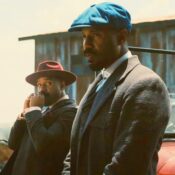American River
⭐️ ⭐️ ⭐️ ⭐️
Run Time: 1 hour 26 minutes
Documentary
Featuring: Mary Bruno, Carl Alderson
Writer: Mary Bruno
Director: Scott Morris
Streaming on PBS Passport; DVD/Blu-ray at americanriver.film
Rivers are Nature’s storytellers: They emerge as peaceful prologues, develop into a series of intriguing twists and turns, endure measures of delight and tragedy, and eventually find grand resolution in a spectacular fantasia of land, sea, and sky.
It’s true for the Nile. It’s true for the Amazon. And, as director Scott Morris proves in this picturesque and challenging documentary, it’s even true for New Jersey’s Passaic River, the long-neglected course that for centuries endured abuse from the smokestack industries that flourished along its banks — yet continues to inspire stubborn affection from people who refuse to give up on what is famously regarded one of America’s most polluted waterways.
For a spring-to-sea kayak journey along the Passaic, Morris has engaged author Mary Bruno — who grew up along the Passaic and wrote a book about it — and Carl Alderson, a New Jersey restoration ecologist. As the pair paddle the river’s twisting 80-mile length — accompanied by Ben Morris’s lovely, almost subliminal jazz piano — their progress is captured by cameras at every imaginable angle: from “kayak cam” mounts to shore-based vantage points to soaring drones.
In the early, upstream scenes, the pristine Passaic is as bucolic as you can imagine; a fast-moving, forested creek that rushes past 18th century homes and under fallen trees that provide frequent obstacles to the kayakers.
But as if to foreshadow later chapters, before long the pair begin to encounter pools of chemical foam and patches of plastic bottles. (Fishing a mini basketball from the water, Alderson shyly admits he has a whole collection of ball-themed pollution.) Soon, for every meandering stretch through areas with majestic names like The Great Swamp and Great Piece Meadows (all lovingly photographed by Morris) there’s a concrete-lined corridor dominated by crumbling brick factories and municipal public works parking lots. A visit to the Great Falls of the Passaic — among the nation’s most spectacular cataracts — vividly portrays the combination of potential hydropower and beauty that inspired Alexander Hamilton to make Paterson, New Jersey, the center of American industry.
For the final 17 miles before the river empties into Newark Bay, the Passaic River’s Jekyll-Hyde transformation is complete: As Bruno and Alderson circle Newark’s Ironbound district — site of a decades-old Superfund toxic chemical cleanup site — one fears that their kayak paddles may dissolve.
But the film accomplishes much more than simply bemoaning “Look what they’ve done to my river” (although it does that, graphically). American River is, above all, a human-focused film, as Bruno and Alderson frequently stop along their journey to visit with people who made the river’s environs their home. Some characters are what you’d expect, from the aristocratic couple who have restored a Colonial-era house upstream to the strident environmentalists who are fighting to turn back the ravages of pollution down in Paterson and Newark.
But sometimes, almost miraculously, Morris’s camera stumbles upon unforgettable bit players in the river’s story: A lifelong resident of the Great Piece Reserve fights back tears as he recalls finding thousands of tiny frog carcasses, flattened by traffic on a new Interstate that bisected the amphibians’ migratory route. “They never had a chance,” he sniffles. A startlingly erudite homeless man, collecting scrap metal from a long-defunct factory, describes himself as “blessed” to have found a small room he could call his own in the abandoned complex. A middle-aged businessman remembers a Huck Finn-like childhood on the lower river, which at the time almost certainly flowed with a concentration of chemicals even more corrosive to human life than it is today.
Bruno and Alderson are agreeable company for the voyage. They banter playfully and react with appealing awe when actual nature — like a nesting bald eagle — introduces itself. Their shared love for the Passaic — and pragmatic outlook on what can and cannot be done to help it — make American River something immeasurably more useful than a seething environmental screed. It’s an affectionate appreciation of what remains…and a blueprint for ways in which countless other American rivers may write their own happy endings.
Become a Saturday Evening Post member and enjoy unlimited access. Subscribe now



